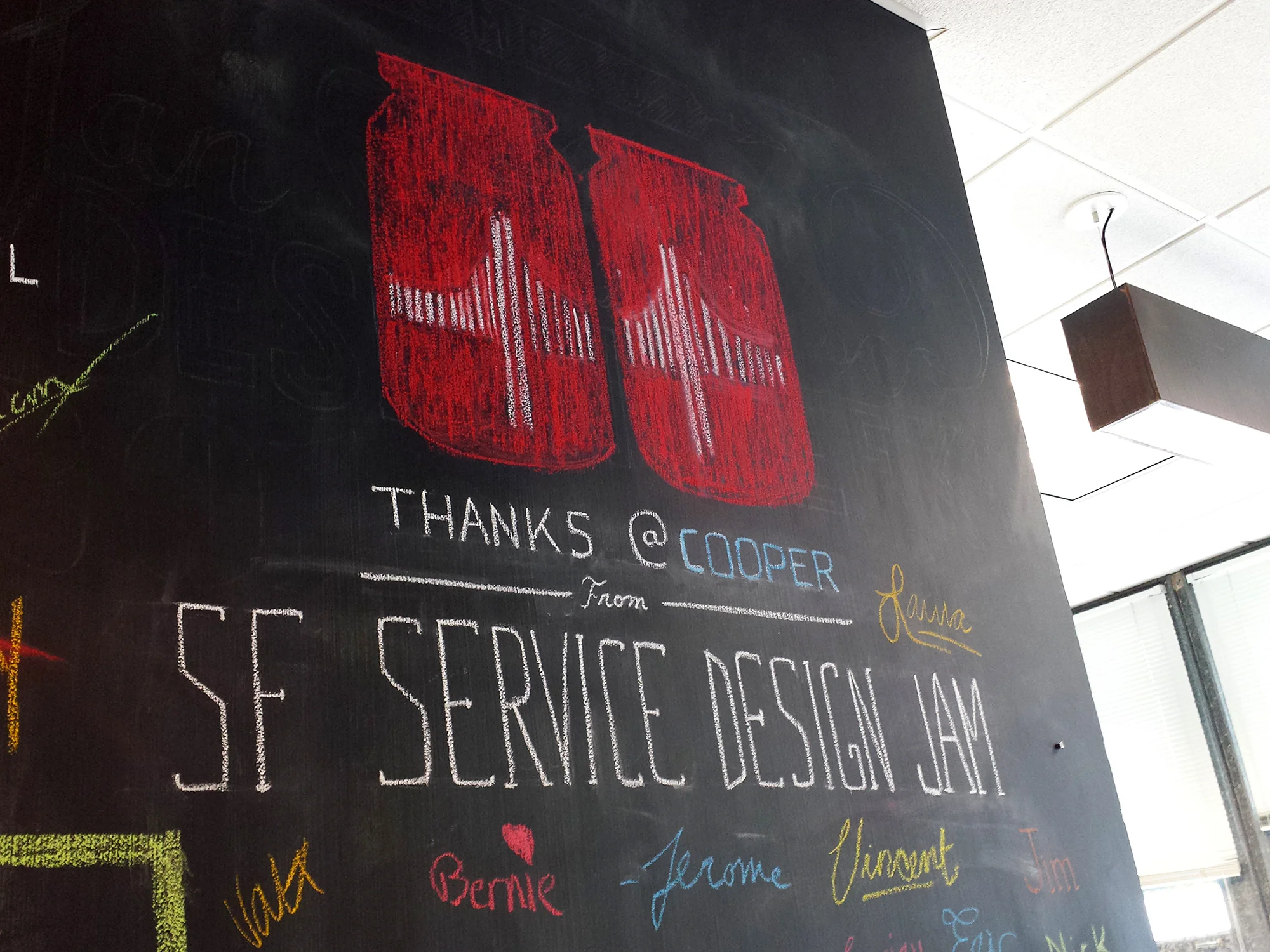4 designer team | 2 days (!) | Side project - Global Service Jam SF | 2014
SERVICE CONCEPT OVERVIEW
Nomad is a destination-oriented packing service that alleviates the expense, anxiety, and monotony of travel luggage.
NoMad's packing service lets people pack online and have their clothes, hygiene items, and essentials ready for pick-up at their destination. The concept combines the ease of a "RedBox"-esque pickup experience with the cultural immersion of AirBnB. You pick your size, identity, and style via our online portal before your trip and everything you need for your adventure is ready and waiting at your destination.
PROCESS IN-DEPTH
PROMPT
Work with a team of strangers to develop a realistic prototype for a new service in just 48 hours as part of the Global Service Design Jam. The Service Jam's big theme is "doing, not talking." The idea is to put aside the spin and let the prototype tell the story. So watch the video first, but if you want the behind the scenes story, read on...
APPROACH
After an evening of brainstorming around the topic, I joined with others interested in prototyping a service around the idea of "Airbnb for travel clothing."
The idea was to make it easier to travel by renting clothes onsite at your destination when traveling. We choose to focus on adventurous travelers who, whether traveling for work on fun, wouldn't need the same outfits for every trip because we wanted our service to provide more than just shipping of your existing wardrobe.
RESEARCH
Just because you're limited in time doesn't mean you can't do research! We made a quick research plan and then hit the streets to see how they approached packing and clothing for travel.
IDEATION & DESIGN
We used a number of service design frameworks and tools as well as good old fashioned post-its to start hashing out how the service would actually come together. With limited time we tried not to get hung up on details, but plenty of healthy debate ensued about the many possible routes for funding and developing the service. A quick blueprint was very helpful to see all the needs and logistics we needed to account for, and the business model canvas helped us think about advantages and disadvantages of different value exchanges.
SERVICE PRINCIPLES
As we ideation we fell into some informal principles / value prop elements that helped guide us through the myriad of decisions we needed to make. We wanted to help travelers:
"BELONG ANYWHERE"
Before this became the new Airbnb slogan, we were thinking this was an unmet need for travel clothing.
Our teammate from Brazil pointed out that bright, busy patterns were THE style for workout leggings in Brazil, at a time when in the US black was the only color your could buy. You'd stick out as an obvious tourist sporting your black lululemons in Rio! As she predicted, two years later the trend has come to the US and everyone's now sporting colorful workout pants.
But what if you could land in a new place, and be able to blend in a little better by following cultural clothing norms? Not by appropriating traditional attire mind you, but just by making it easy to blend in a bit by dressing up a bit with minimalist black in New York, and going hip casual for SoCal.
PLAN ACCORDINGLY
The hassle of packing for a trip isn't just about physically moving the items from place to place, it's also about gathering and preparing them. We wanted to allow travelers to choose the items they wanted for a trip quickly and easily, and even help them out in deciding by letting them know what they might need based on the weather and popular activities at their destination.
TAKE MEMORIES HOME
Part of the fun of building a service is to get creative with the business model. Once we hit on the idea of having people try out unique clothes in different destinations, we added the possibility of getting the clothing at low cost as promotion. We figured some people would also want to keep some of the clothes they discovered traveling, with a fun try before you buy model. Unlike many mail-order clothing rental services, our had an added advantage in this realm - it's now attached to a happy travel memory. Our quick research found people loved to have origin stories for the things they owned and wore, so we felt that wearing an outfit on a fun trip would make them even more likely to purchase it if it was a good fit. This model also takes advantages of people's natural loss aversion to not want to give up the clothes they've grown attached to, and fundamental attribution bias where they're likely to like the clothes more because they're associated with their fun trip.
EXPERIENCE A SEEMLESS, END-TO-END SERVICE
This opportunity exists because dealing with bags when traveling is a hassle. We knew to succeed our service would need to anticipate and eliminate as many possible hassle painpoints as possible.
We tried to make the clothing "shopping" experience quick and easy, while still letting the user pick their own items if they chose. For those with less time or preferences, we offered recommended kits as well.
On the destination side, we originally wanted to deliver a traveler's clothing directly to her hotel. But we knew that customer expectations were high with this type of high-touch and high-stakes experience, so we wanted to simplify to eliminate as many possible failure points as we could. After all, just one bad experience that leaves a traveler with no clothes in a foreign country (!) would turn them from a fan to all-star detractor in no time. So we decided delivery could be an add-on service, but the core experience would have airport pick-up and drop-off, giving us greater control and less moving parts.
We also incorporated a few service-recovery opportunities to quickly fix anything that could go wrong, such as having some extra supplies available onsite at the pickup station in case an order was bungled, and alerting a user if they seem to be under-packing for a trip.
BE DELIGHTED
In order to be the perfect antidote for the stress and dehumanizing unpleasantness of modern air travel, we wanted to make our service cheery and fun. We wanted to let travelers know that we were on their side, and looking out for them. To that end we added some special touches, like a note from the person who prepares your bag, a ribbon around the bag, and some unexpected welcome gift.
PROTOTYPING
Having now fallen fully in love with our ideas, and having thought surprisingly thoroughly through the service, we now how to make all that thinking come to life. We had to prototype the whole service experience, and get it on video ready to share to the group, in just a few hours. Acting out the service gave us a chance to illustrate some, but not all, of the articulations of our principles that we intended to include. We had to throw together a basic play-by-play, "screens" for our shopping experience, and a set for all of the backstage and frontstage action, and actually make the video. We had to cut out some service recoveries and other nuances for time and simplicity's sake. Luckily one "take" of the video did our ideas decent justice, because that's all we had time for!
RESULTS & REFLECTIONS
The goal of this project was just to learn and have fun, and I'd say in that regard it was a great success. I had a great time going from forming to performing so quickly with a small team of different types of folks.
I really enjoyed thinking through the service, hashing out the details, and bringing it to life. Our concept was very well received within the SF Jam group, and I later saw a similar service launched IRL, though they focus more on business travelers. Hard to say if they were inspired by our work, but either way it's good to see more startups taking a truly service-oriented approach rather than just providing a function.













